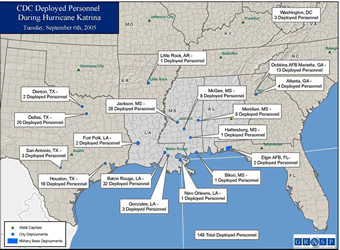|
From the CDC Director’s Emergency Operations
Center - P.M. Update, September 6, 2005
Top Line - Public Health
Rapid public health assessments are ongoing. Infection control
in evacuation centers is a priority. CDC is helping with mosquito
control strategies.
National Public Health Emergency Situation
Update
- Persons in Evacuation Centers: 229,000
people across 11 states
- Lives saved by USCG: 22,800
- Citizens evacuated: 273,000
- Relief supplies: 8.5 million MREs, 15
million liters of water, 100 tons first aid supplies
- Damage assessments: .98 million (1.25
million without power 9/5)
- Official death numbers: AL 2, FL 11,
MS 162, LA X. Total: 175
CDC Public Health Workforce Deployed
in Affected Communities
- Total: 148 (141: 9/5) including the following
specialties: medical, epidemiologist, sanitation, environmental
health, assessment, disease surveillance, public information
and health risk communication).
- By State: DC 3; FL 2; GA 17; LA 38 (35
09/05); MS 43 (44 9/5); TX 44 (40 9/5) AR 1 (See
map for deployment locations)
- Preparing to Deploy: 50
- Deployed to Director’s EOC: 64
(As of 9/3)
CDC Public Health Analysis
The threat of infectious diseases
in evacuation centers is a primary concern. CDC deployed
staff have reported gastroenteritis,
including clusters of noro virus in evacuation centers.
Infection control measures in evacuation centers
include rapid
detection, separating ill patients and families from the
general shelter population and vigorous and consistent
handwashing.
CDC is working with local and state public health officials
and clinicians in shelters to conduct rapid disease detection
and ongoing disease surveillance. CDC is encouraging up to date vaccinations for persons living
in shelters and is assisting local and state public health
officials to screen and vaccinate children and adults living
in evacuation centers.
Vector Control: Mosquito and vector control
is an urgent concern in affected communities where stagnant
water has pooled. CDC is developing mosquito control strategies,
including working with other agencies as they conduct aerial
spraying and guidance on vector control activities.
CDC’s environmental and occupational health specialists
are providing occupational health screenings for responders
and persons evacuated.
Growing Concerns: mental health and coping
strategies for individuals, community resilience, and injuries
as people return to damaged communities.
Public Health Recommendations Pass it On
Although the possibility of an outbreak is low in a vaccinated
U.S. population, it is possible that outbreaks of varicella,
rubella, mumps, or measles could occur. Although measles and
rubella are no longer endemic to the U.S., introductions do
occur, and crowded conditions would facilitate their spread.
Hepatitis A incidence is low in the affected areas, but post-exposure
prophylaxis among persons in evacuation centers would be logistically
difficult and so vaccination is recommended. In addition, the
influenza season will begin soon and influenza can spread easily
under crowded conditions. To reduce the likelihood of outbreaks
of vaccine-preventable diseases in large crowded group settings
CDC encourages people to be up-to-date for vaccinations.
Childhood and Adolescent
Immunization Schedule:
www.cdc.gov/nip/recs/child-schedule.htm
Adult Immunization Schedule:
www.cdc.gov/nip/recs/adult-schedule.htm
CDC Response
Today’s Snapshot
CDC has sent 3,500 beds and critical medications including
for conditions such as diabetes, heart disease, high blood
pressure, pain, anxiety, and diarrhea to the affected areas.
Many of the basic pharmaceuticals were in place within hours
of the hurricane’s passage.
CDC deployed from its Strategic National Stockpile a 12-hour
Push Package to Mississippi. A 12-hour Push Package is designed
for rapid deployment and delivery, and contains a broad spectrum
of medical supplies: Each 12-hour Push Package includes: oral
and intravenous drugs to provide post-exposure prophylaxis
and therapeutic treatment. The package also includes: catheters,
IV administration sets, antiseptics, and other supplies needed
to provide IV therapy and emergency medications.
CDC delivered the following vaccines to Louisiana:
- 90,000 vials of tetanus/diphtheria – treats 90,000
people
- 10,000 vials of hepatitis A vaccine – treats 22,000
people
- 10,000 vials of hepatitis B vaccine – treats 36,000
people
CDC delivered 10,000 vials of insulin to Mississippi and 20,000
vials of insulin to Louisiana.
CDC launched a special flight on September 1, 2005, for rapid
delivery of prescription pain medications to Louisiana. A shipment
of 28 ventilator kits was also delivered to the airport in
New Orleans, to aid in evacuation of patients with critical
health concerns.
CDC Internet Traffic: Most popular pages:
infectious disease and healthcare provider and worker safety
information. Most traffic is coming to CDC site from AOL's
government guide and other federal agencies.
Where to Find Out More About
CDC Grant Funds: CDC has posted guidance
to its State Health Department grantees about use of CDC grant
funds in response to hurricane Katrina.
www.bt.cdc.gov/disasters/hurricanes/katrina/pdf/
grantuse.pdf
Professional volunteers: The Federal Government
is mobilizing and identifying healthcare professionals and
relief personnel to assist in Hurricane Katrina relief efforts.
As our nation and global community is now aware, the healthcare
needs resulting from Katrina are critical.
Please go to: www.bt.cdc.gov/disasters/hurricanes/hhs_
announcement.asp
Donations: For donations of housing, transportation,
medical equipment, supplies, and medications, the National
Emergency Resource Registry (NERR) has been activated by
the Department of Homeland Security (DHS). To volunteer these
types of resources, please register with the NERR. More information
on the NERR is included at www.swern.gov/.
FEMA Updates: Please go to www.fema.gov/
Family Links Registry: Please go to www.redcross.org/

Click on map for larger image |



